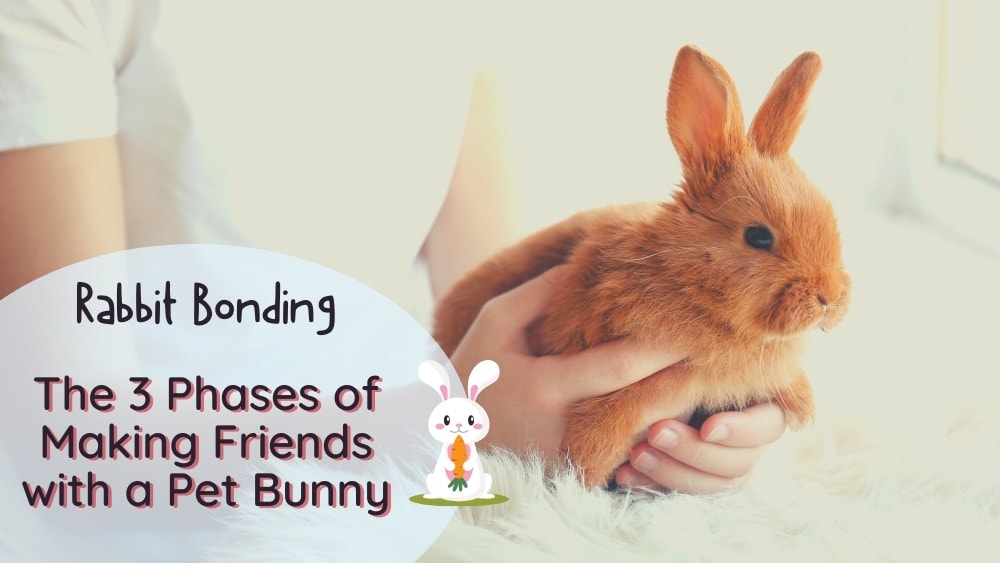Bonding with a pet bunny is like building a relationship with any other sentient being: the more time you spend together, the more quickly you’ll learn to read each other.
Bonding with your rabbit starts with laying aside preconceived expectations of what bunnies should be like and allowing your pet to express its own personality. I’ve kept several pet rabbits over two decades and they’re all sweet and all hilarious – but all different.
Maybe your bunny will be like my Baxter, who would trot at my heels around the house (and the yard.) Maybe your bunny will be like my Kayla, who appointed herself my housekeeper and fussed over every rumpled rug or toy that was out of place. Or maybe your bunny will be like my snuggle-bunny Sage, who nestles into my lap when I sit down for a phone call.
So if you’re ready to discover your rabbit’s unique charm, try my simple, three-part method for bonding with a bunny!
How Do You Bond with Your Pet Rabbit?
To bond with a newly adopted pet rabbit, take things in phases:
- Give your rabbit time to settle into its surroundings while you observe its personality.
- Give your rabbit opportunities to trust you and like you.
- Once trust is established, develop and enjoy your relationship through petting and playtime.
You might move through these stages in a few weeks, or it could take 3-6 months. The time it takes to bond with a pet bunny depends on your rabbit’s age and preferences, general circumstances, and your time investment. The tips (and game ideas!) in this article will help you learn your rabbit’s body language and speak fluent “bunny” as quickly as possible.
Phase I: Getting to Know Your Rabbit’s Personality
You can’t judge a pet bunny’s personality at the shelter any more than you can judge a new human friend by looking at them across the room. The shelter workers may give you their impressions of your rabbit, but you’ll have to bring Bunny home and start interacting before you can really understand each other.
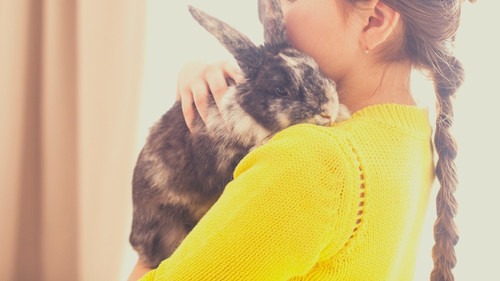
Bunnies find moving and change scary. “Rabbit Bonding Phase I” focuses on making your rabbit feel comfortable in its new home so its true self can shine.
Tip: Neutering or spaying your rabbit may make it easier to build a bond with them. However, don’t be afraid to begin bonding before your bunny is old enough for surgery. Your relationship may change a bit after your rabbit’s operation, but only for the better.
1 – Create a Great Habitat
Before you bring your rabbit home, create a fantastic habitat filled with safe spaces to hide and lots of things to do. Rabbits love tactile toys like digging boxes and gnawing mats. The enclosure needs to be large enough for a rabbit to run and jump. This will give your rabbit a chance to express itself in whatever way it’s most comfortable.

2 – Give Your Bunny Space
Don’t rush into handling your new rabbit. For the first week or two after you bring your bunny home, let it make its space its own. Keep its environment quiet – free of squealing children or predators like cats and dogs.
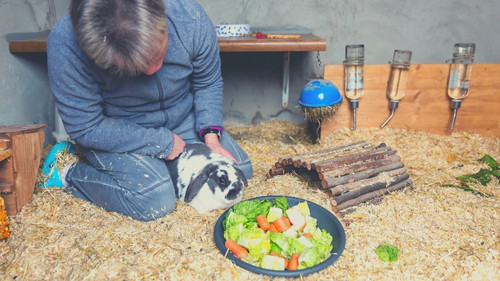
Create a regular routine. Give your bunny its pellets at the same time every day and follow that up with a cup of fresh veggies and exercise out of the cage. When rabbits can anticipate what happens next, it will build trust.
Tip: Rabbits are most energetic at dawn and dusk. They prefer to snooze during the middle of the day and night. Time your interactions with your bunny around its active hours for best results.
3 – Observe Your Bunny
Swap out toys, tunnels, and nesting materials. (For example, try brown paper vs. straw in the digging box.) Watch your rabbit and take mental notes on how it responds to different sensory activities. Does your bunny love to be busy? Is he happy-go-lucky or will she not leave the cage until her nest is tidy? Is food the way to its heart?
Be as gentle and quiet as you can during the observation phase because your bunny is taking notes on your behavior, too!
Phase II: Getting a Rabbit to Trust You
Once your rabbit has made your home its own, you can begin to interact with your bunny directly. Phase II of bonding with your rabbit has two purposes: assuring your bunny that you aren’t a threat and teaching it to associate you with good things.
1 – Sit With Your Rabbit
When your bunny is out of its enclosure for exercise, sit on the floor in the same room. You can even lie down on the floor, but lie still – even if your rabbit climbs on you! The key is to get down on your rabbit’s level and give it the choice to sniff, nuzzle, and approach you when it is ready. Avoid any sudden motions or noises. (In other words, try not to sneeze.😉)
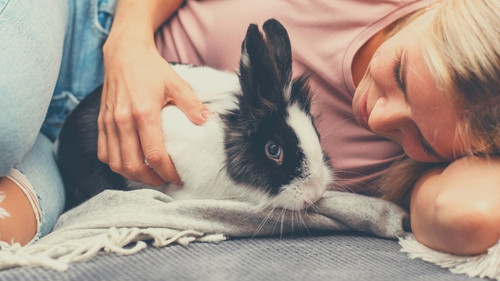
2 – Talk to Your Rabbit
Talk softly to your bunny – or simply talk on the phone in the room with your rabbit. Let your bunny get used to a calm, steady tone. While it’s best if your rabbit gets used to your voice, some people say that playing talk radio on low around their rabbits helps them settle.
Be careful about music, though. Music that you find relaxing could frighten your rabbit. I’ve seen bunnies pick up rhythms that bothered them and freak out at music that I find calming.
3 – Don’t Corner, Trap, or Grab Your Bunny
Whatever you do, don’t grab your bunny! When your rabbit puts a cautious paw onto your knee, that’s not an invitation to clutch and cuddle him! (Believe me, if you resist the temptation now, your turn will come much sooner!)
You need to prove to your bunny that, if it ventures to come close, you won’t snatch him up and carry him off to your den the way a fox would. That would teach your rabbit to view your hands – specifically your hands – as a predator. If this happens, your rabbit may run away from you or even attack your hands when you reach for him.
Let your rabbit get used to your hands by resting them on the ground below your rabbit’s eye level. If you do reach for a rabbit, keep your hands low. Rabbits can see straight above their heads; hands grabbing them from above will trigger ideas of a hawk swooping down.
4 – Offer Treats
A great way to teach your rabbit to trust your hands is to offer treats. This works best if you choose a treat your bunny recognizes and enjoys; one it has had before in its food bowl. Simply hold the treat in your hand at floor level and wait for your bunny to approach.
Consistency works in your favor again here. If you begin every exercise session with a treat in your hand, your rabbit may soon approach, nuzzling your palm to look for it.
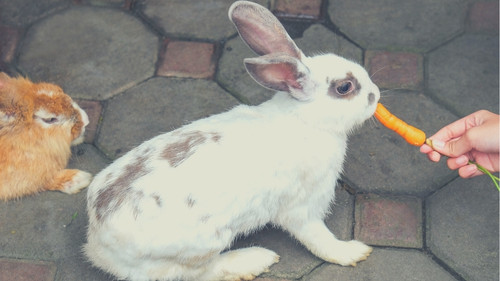
Great treats for bunnies include leafy green veggies and herbs and certain fruits like bananas and blueberries.
5 – Pet Your Rabbit
The time has come! You may pet your bunny.
Not to be dramatic, but it does taste like victory once your bond is established with your rabbit and it asks for your hand in petting.
Once your rabbit is comfortable around your hands, you can slowly move them around your bunny’s body and discover where it likes to be pet.
Most rabbits prefer their head and ears petted and don’t want you to touch their feet, tail, or stomach. Our guide to petting a rabbit will give you extra pointers.
Some bunnies only tolerate petting, but others eat it up and will lean deep into your hand for a massage. It’s pretty adorable.
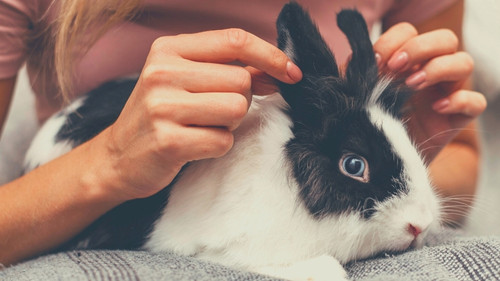
6 – When the Bond is Built – Handle Your Rabbit
This is a bit of a controversial take, but hear me out: you should eventually learn to pick up your bunny. Many rabbit educators love to remind pet owners that rabbits feel threatened any time their feet leave the ground. (Because, in the wild, this would never happen unless they were about to be eaten.)
There’s truth to this. However, I think it’s an insult to your rabbit’s intelligence to say it can’t learn to trust you enough to not be terrified when you lift it off the ground.
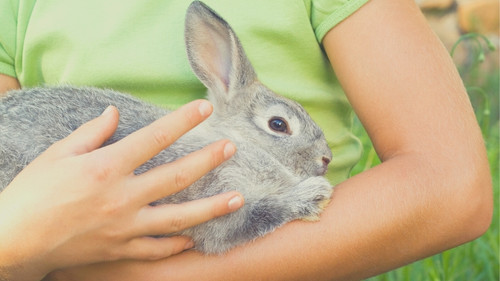
Even though most rabbits never prefer to be picked up, there are times when you must do it for its safety. For example, to move your rabbit to a carrier, to rescue it from sudden danger, or to check it over for illness – which you should do regularly.
In my experience, rabbits get used to being handled, and – in the end – this is better for them. This way, in an emergency situation, both you and the bunny are comfortable with each other. The bunny is less likely to struggle and you are less likely to be scratched and drop him.
However, when you pick up a rabbit, always do it from underneath. Never, ever lift a bunny by its hips, its ears, or the scruff of its neck.
7 – Use Positive Reinforcement
Rabbits can be naughty, and need to learn your house rules. Train your rabbit which things they can chew on and which they can’t with positive reinforcement.
Never strike your rabbit or yell at it. If your rabbit gets into something off-limits, clap to get your bunny’s attention and then gently redirect.
Phase III: 12 Fun Bonding Activities with Your Rabbit
And now for the fun part. Once you’ve learned more about who your rabbit is and what to expect from it, your bunny probably feels like it knows you, too. Your bond is built; now you can tighten it with some of these fun games to play with your pet rabbit.
1 – Groom Your Bunny
Buy a breed-appropriate brush for your rabbit and give it a thorough massage. Grooming is a social behavior in rabbits. If you give your bunny a grooming session it loves, it may turn around and lick your hands in return!
2 – Create an Obstacle Course
If you have an Energizer Bunny, it may love a homemade maze or obstacle course! Create one with climbing challenges, tunnels, or even jumps and see how your bunny does! Brown cardboard boxes work great for this, because they’re generally safe even if your rabbit chews them. You can also get fancy and use climbing towers made of wood.

3 – Teach Your Rabbit To Jump
Did you know that rabbit hopping is a competitive sport? Rabbit agility is, too! And why not? Rabbits can leap up to 4 feet vertically and 9 feet horizontally! Unleash your rabbit’s inner athlete with some fun hopping training!
You can either buy jumps for your rabbit, or train it to hop through a hula hoop. Either way, you’ll want treats and a clicker for positive reinforcement.

4 – Walking on Hind Legs
Another trick that’s easy for rabbits to learn is to stand or take baby steps on their hind legs. Standing upright is a natural position for rabbits; they frequently use it to scan their surroundings. (It’s called periscoping!)
5 – Play Tag or Hide and Seek
Some bunnies love to play tag. You should never aggressively chase your rabbit. But if your bunny hops up to you, nudges your leg, and then runs away with its tail twitching, it definitely wants to play! My Baxter loved it when I would slow-run after him, and I was always amazed when he would chase me in return.
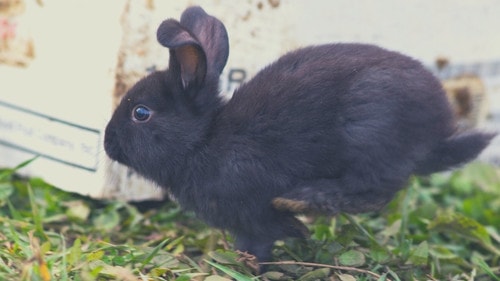
6 – Stage a Photoshoot
If you have a more chill bunny, it may not mind participating in a photo shoot. You should do this in your home if possible, because traveling to a new environment like a studio would stress your rabbit. It doesn’t take a lot of space to set up a beautiful background with adorable props (hint: check the stores around Easter time) and create some images you’ll treasure.
7 – Create a Bunny Birthday Salad
Call me silly, but I like to give my bunnies something special on their birthdays. Usually I’ll put together a salad of fresh greens and herbs sprinkled with a bit of cut strawberry and just a tiny sprinkling of sunflower seeds or rolled oats.
Remember, though, never feed treats in excess – not even once a year. If your rabbit’s gut bacteria aren’t adapted to handle significant amounts of carbohydrates, just one large helping of sugary or starchy food could put it into life-threatening GI stasis!
8 – Tease Your Bunny in Nice Ways
Rabbits have such a high opinion of themselves that I can’t resist teasing them a little.
Once you and your rabbit are truly best friends, you can poke fun at it just a bit by hiding a toy or a treat in your hands, or pretending you’re done petting it when it’s asking for more. Or maybe you’ll smooth out the corner of a towel that your bunny had just scratched up into a perfect wad (in its own mind). None of these things will bother your rabbit too much, and it gives you a chance to be involved in its world.
9 – Sit and Do Life Together
Some rabbits will never be comfortable sitting in your lap. If that’s the case with your rabbit, you will need to respect its boundaries if you want to bond with your bunny.
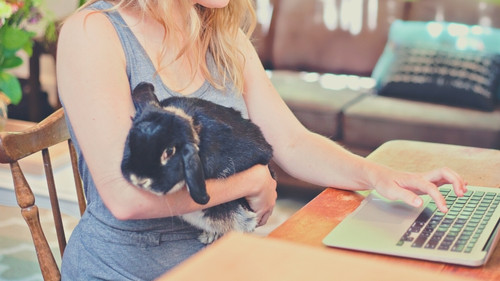
But many bunnies, once they are very comfortable with you, will be happy to rest in your lap for a few minutes or flop down beside your legs while you sit on the floor and read, text, or watch a movie. This implicit trust from a tiny creature is so heartwarming it’ll be worth all the work it took to get there.
Frequently Asked Questions
How Long Does it Take to Bond with a Rabbit?
Bonding with a rabbit usually takes between 2 weeks and 3 months. It depends on the age of the rabbit, whether it is spayed/neutered, the amount of time you put into working together, and whether you have any major setbacks. The biggest factor in bonding with your bunny is your rabbit’s personality. Outgoing rabbits tend to bond quicker than introverted ones.
Why Does My Rabbit Lick My Hands?
Many people say rabbits lick your hands because they like the taste of salt, but that’s not true! Licking is a social behavior for bunnies; they lick you because they want to bond with you. Usually rabbits will lick you after you groom them or if they want you to groom them in return. They may lick you just because they see you as a friend.
How Do You Pick Up a Rabbit Without Scaring It?
Avoid chasing your rabbit before you pick it up. If it’s already terrorized by being chased, picking up your rabbit will “prove” to it that you mean harm.
Instead, in a moment of calm, reach one palm under your rabbit’s belly and support its rear with the other hand. Bring all four feet to rest against your chest and hold your bunny firmly. Never grab the ears or the “scruff” on the back of your rabbit’s neck!
Conclusion
In my experience, the more a human invests in a rabbit, the more the bunny’s personality develops. Rabbits can make excellent companions if you treat them as bunnies and not import expectations from your relationship with other pets of other species. The keys to bonding with a rabbit are patience, letting the rabbit take the lead, and earning your bunny’s trust. Your bunny will soon reward you with more happiness than you expect!
This article focused on human-rabbit bonding. If you’d like to know how to get two rabbits to bond with each other, please read “How to Introduce and Bond Rabbits.”


